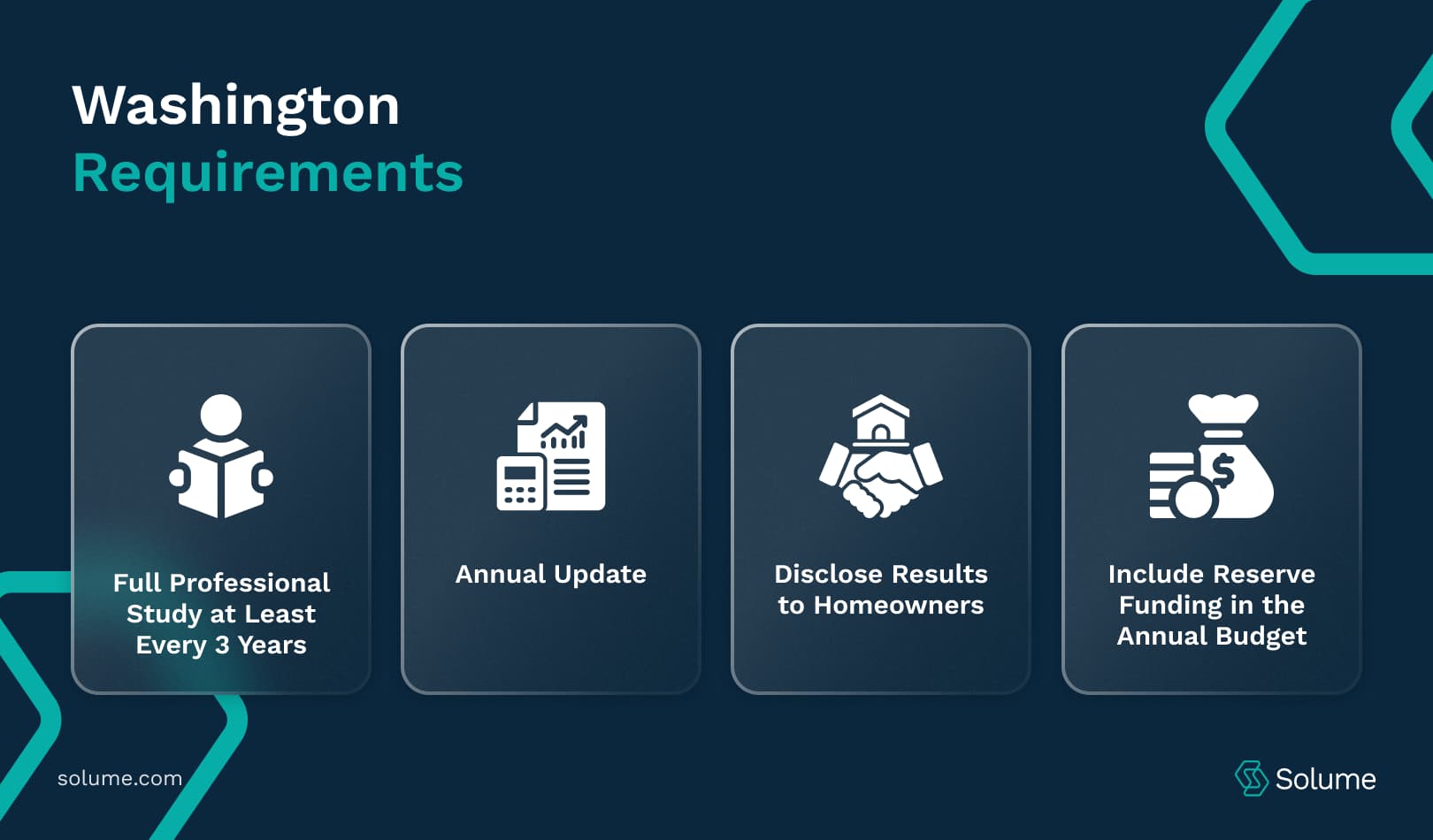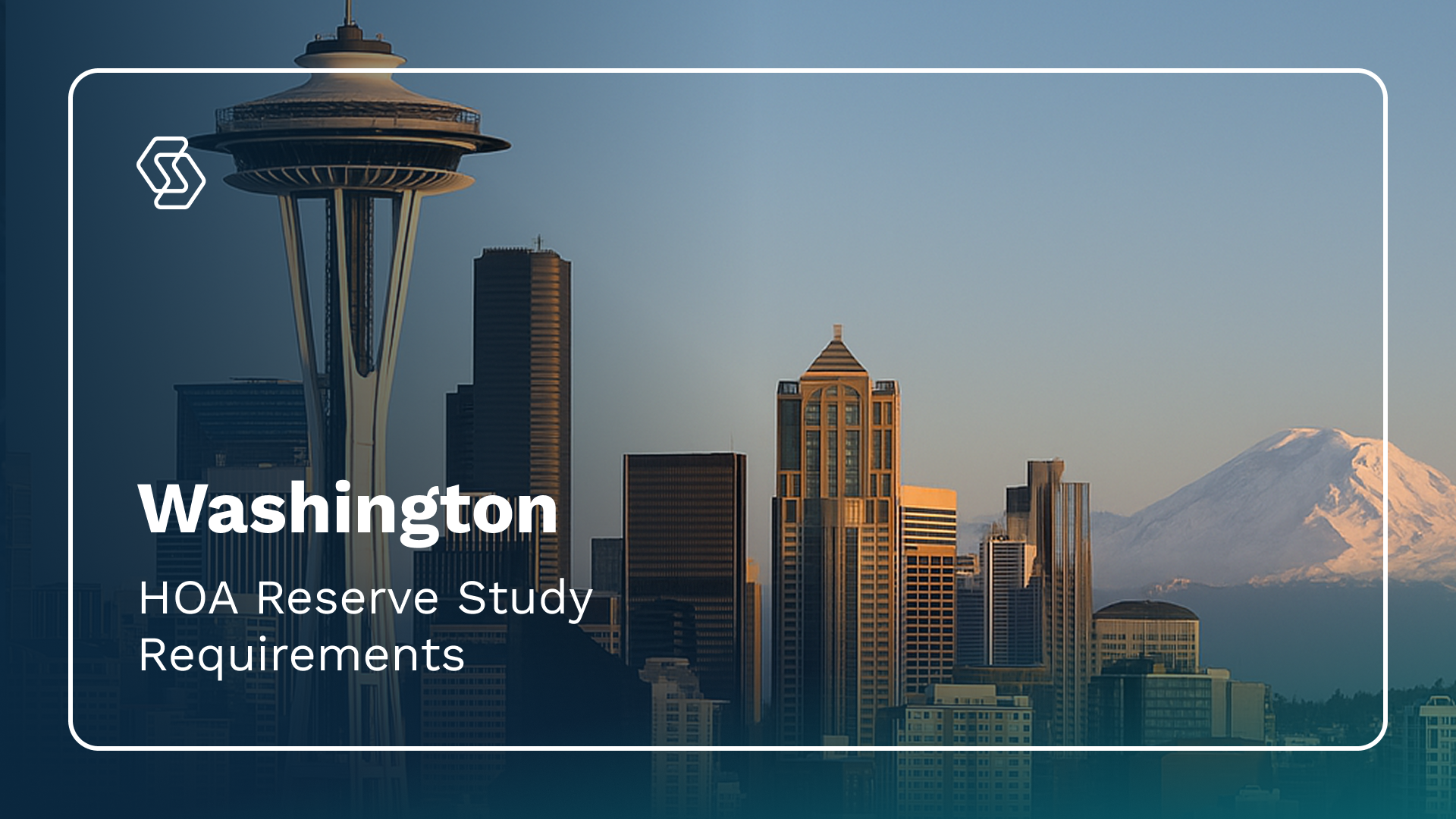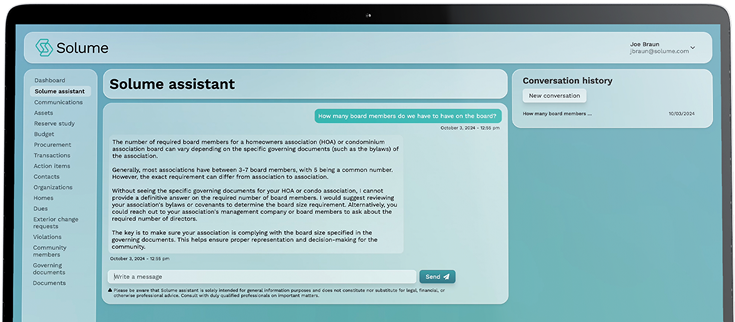Key Takeaways
- Washington State law (RCW 64.38.065 and RCW 64.34.382) strongly encourages associations to conduct reserve studies and keep them updated to ensure long-term financial and structural stability.
- Condos and HOAs must complete a professional reserve study every three years and perform annual updates in between.
- These laws exist to protect homeowners from surprise special assessments and preserve property values through consistent maintenance planning.
- A professional reserve study acts as both a financial planning tool and a roadmap for maintaining the community’s structural integrity.
- Technology platforms like Solume simplify compliance by helping boards manage updates, budgets, and funding plans in one place.
What Are Washington HOA Reserve Study Requirements?
Defining an HOA Reserve Study
Under RCW 64.38.065, these requirements apply to associations with what the law calls “significant assets.” That commonly means communities that own or maintain shared property, common areas, or major building systems like roofs, elevators, plumbing, or structural supports. (RCW 64.38.065 Reserve Account and Study, 2023) Smaller single-family associations with limited shared property might be exempt if the cost of a reserve study would create an unreasonable hardship. Adding this definition early helps readers quickly understand whether their association qualifies. A reserve study is a financial and structural assessment designed to help homeowners' associations and condo associations plan for long-term maintenance and major repairs. It provides clarity about the estimated remaining useful life and estimated cost of every shared element—from roofs and siding to elevators and asphalt.
In Washington, there is a little bit of gray area. Depending on how you read the law, reserve studies are either “strongly encouraged” or required - it comes down to how you interpret “significant assets”. The RCW 64.38.065 statute for HOAs and RCW 64.34.382 for condos require every association to prepare and maintain one. (RCW 64.38.065 - Reserve account and study, 2024) These studies ensure that each community can plan for future repairs, track deferred maintenance expenses, and fund reserves responsibly.
A Reserve Specialist or licensed engineer typically conducts the study, evaluating common area components, structural components, and major repairs needed over a 30-year horizon. The result gives the board a clear financial roadmap—a plan that protects both the property and its people.
Solume takes that concept further. Instead of a static PDF, Solume turns the traditional reserve study into an interactive dashboard where board members can visualize funding gaps, test scenarios, and align their annual budget with real-time data. It’s the difference between reacting to problems and managing them with foresight.
Legal Requirements Under Washington Statutes

Under RCW 64.38.065, these requirements apply to associations with what the law calls “significant assets.” That generally means communities that own or maintain shared property or major building systems—such as roofs, elevators, plumbing, or structural supports. Smaller single-family associations with minimal common property may be exempt if preparing a study would create an unreasonable hardship. The goal is to ensure that associations with meaningful shared responsibilities are planning responsibly for future repairs. Under Washington law, every association must:
- Complete a professional reserve study every three years.
- Perform annual updates and disclose the results to homeowners.
- Include reserve funding details in the annual budget.
- Identify the fund reserves necessary to cover long-term repairs and replacements.
These requirements ensure that every association maintains financial stability and complies with state law. We’ve all heard the horror stories: Boards that skip or forget to conduct updates not only risk falling behind on maintenance but also violate legal requirements that protect homeowners and lenders. Many people think this is how boards screw community members over because this often leads to special assessments.
Washington’s law is designed to ensure boards don’t fall behind, communicate clearly, and remain accountable to their homeowners. Associations that keep their reserve studies current are not just better off; they protect property values and prevent the kind of financial situations that force people into selling their homes because they can’t pay the special assessment.
Why Reserve Studies Are Crucial for Washington HOAs
Protecting Property Values and Structural Integrity
We’ve said this hundreds of times: Reserve studies aren’t just bureaucratic red tape; they’re necessary preventative plans. They preserve property values, prevent safety risks caused by wood rot, mold, and any other number of issues through wear and tear, and maintain the structural integrity of your community. In a region where moisture, weather, and time take their toll (especially in coastal regions), small issues like roof leaks or siding decay can quickly become major failures.
By staying proactive with structural integrity reserve studies, associations avoid costly emergencies. Consistent funding ensures critical systems, such as electrical systems, plumbing, and roofing, are repaired or replaced before they fail. Preventing wear and tear is more than maintenance; it’s asset protection.
Financial Health and Avoiding Special Assessments
The surest sign of a healthy association is steady reserve contributions. Underfunded reserves almost always lead to special assessments, which cause frustration and financial strain among residents. Washington’s reserve study law exists to reduce that risk by requiring boards to plan ahead.
By using tools like Solume, boards can run multiple funding scenarios and instantly see how changes affect long-term outcomes. The ability to project costs and timing helps avoid underfunded reserves and makes sure your community has the money it needs when major repairs come about.
Key Elements of a Washington HOA Reserve Study
Inspections and Reserve Analysis
A complete reserve analysis starts with a detailed site inspection and visual inspection by a reserve study company or licensed engineer. Reserve studies typically fall into one of a few categories, including a full on-site inspection, an update with a site visit (meaning, the provider comes back out to inspect work after a period of time), and an update without a site visit (typically via photos). Washington’s law requires a professional in-person study at least every three years to ensure accuracy and compliance. During this process, the specialist evaluates all major components of the property, such as roofing, HVAC, electrical systems, and common structures, to estimate replacement timing and costs.
The process identifies:
- The estimated remaining useful life of each item.
- The estimated replacement cost is based on market rates.
- The total capital expenditures required for long-term maintenance.
Regular reserve study updates ensure the plan reflects current conditions and inflation. When these updates lapse, boards risk relying on outdated numbers that can cause funding shortfalls.
Important Reserve Items and Common Elements
Every professional reserve study includes a breakdown of common elements that qualify as “significant assets” under Washington law. Boards should look for shared systems or structures that the community owns and maintains which fit that definition, ensuring they include everything the statute requires:
- Roof replacement and siding restoration.
- Building painting, waterproofing, and pavement resurfacing.
- Fire protection and electrical systems.
- Elevators, plumbing, and mechanical systems.
Each reserve item receives what is known as a projected lifespan (meaning, how long a particular item has left before repairs/replacements are necessary) and funding target (how much it will cost when the repair/replacement is due), which together form the community’s maintenance plan. Skipping or deferring these updates leads to larger issues that directly impact property values and safety.
Best Practices for HOA Reserve Planning in Washington
Working with Professionals
Boards should always hire a qualified Reserve Specialist or licensed engineer who understands Washington’s specific reserve requirements. (Reserve Study Group | Washington, n.d.) These experts ensure accuracy, compliance, and clarity—especially when translating inspection results into actionable financial plans.
Property managers should play an essential role. (We say should because we’ve seen many communities that have been managed for years, but still the management company failed them.) Property managers should oversee updates, track reserve funding plans, and help align the fiscal year budget with long-term maintenance goals. With Solume, property managers and board members can easily generate reserve study updates, stay compliant, and share results with homeowners in real time.
Engaging HOA Boards and Members
Transparency keeps the chit-chat down. Board members should communicate how reserve funding saves everyone from surprise fees that always hit right before the holidays or family vacations. When residents understand the purpose behind contributions, support increases, and financial planning adoption gets easier.
When major decisions require a majority vote, boards should seek legal advice to ensure compliance with state law and governing documents. Proactive communication gives people a reason to trust the board, and this leads to less resistance to necessary budget adjustments.
Ensuring Long-Term Success for HOAs in Washington
Under RCW 64.38.065 and RCW 64.34.382, Washington’s reserve study requirements aren’t just rules. They really are designed to safeguard communities. While it’s not rocket science, following best practices, maintaining adequate reserves, and performing regular reserve study updates, associations secure long-term stability and financial confidence.
Solume helps boards take it further. It transforms traditional reserve studies into dynamic, interactive tools that integrate with budgets, funding schedules, and compliance reporting. For Washington’s HOAs and Condo Associations, this is how you stay ahead—through clarity, accountability, and technology.
The message is clear: compliance isn’t about paperwork, it’s about protection. When your reserve plan is strong, your community is stronger.
Washington HOA Reserve Study Requirements: Expert FAQs
Understanding Washington’s reserve study laws means understanding how your community plans for the future. RCW 64.38.065 (for HOAs) and RCW 64.34.382 (for condos) require reserve studies for associations with significant assets, and compliance is not optional. Below are the most important questions every board should be asking—and answering—about their reserve responsibilities.
1. Are reserve studies required for all HOAs in Washington?
Yes. Associations that own or maintain significant shared property or major building systems must conduct reserve studies. While some might say there’s a lot of gray area, the law defines “significant assets” as features like roofs, plumbing, elevators, or other shared systems that require long-term upkeep. Smaller HOAs with minimal common property may be exempt if conducting a study would cause an unreasonable hardship, but in practice, most associations qualify.
2. What qualifies as “significant assets” under RCW 64.38.065?
Significant assets include shared or structural elements that would create a financial burden if they failed. Examples include roofing, elevators, siding, load-bearing walls, drainage systems, and other structural components. These are items owned collectively by the community that need to be replaced or repaired over time. Identifying these community assets helps ensure the reserve study covers all essential infrastructure and maintains legal compliance with the law.
3. How often does a Washington HOA need to update its reserve study?
The law states that a professional reserve study must be conducted at least every three years and an update every year between full inspections. The goal is to make sure data stays up to date as wear and tear occur. Inflation, supply costs or availability, and unexpected repairs all impact reserve balances. Things happen that even the best engineer doesn’t always anticipate. Regular milestone inspections help boards confirm that the community’s physical condition and funding strategy align, reducing surprises and ensuring long-term stability.
4. What happens if an HOA fails to conduct a required reserve study?
Beyond putting your community on the track for financial disaster, failure to comply with Washington law can have real consequences. Boards that skip required studies risk issues with insurance, loan approvals, and even real estate sales. Lenders and buyers look for proof that the association is managing its finances responsibly. Nothing is worse than buying a home only to find out later that the community is in a downward financial spiral. Without a current study, a community can appear unstable, which affects both marketability and property values.
5. What are the different types of reserve studies recognized in Washington?
Washington recognizes three types of reserve studies:
- Full on-site study: A professional visits the property to inspect all major systems and components.
- Update with site visit: The professional reviews changes since the last study and verifies physical conditions in person.
- Update without site visit: A financial and data-based update using prior inspection data.
Associations are required to conduct a full on-site study every three years. Updates between those cycles keep funding accurate and ensure legal compliance with RCW 64.38.065.
6. How much should an HOA contribute to reserves each year?
Reserve funding varies, but many associations contribute between 10% and 40% of their annual budget. Older communities (i.e., older infrastructure )or less reserves may need higher contributions. The right number depends on the age of the property, the cost of future repairs, and inflation. A well-planned budget helps prevent special assessments and maintains financial stability throughout the fiscal year.
7. What should a Washington HOA include in its reserve study?
A complete reserve study must list all common elements and major repairs needed over the next 30 years. These include:
- Roofing, siding, and waterproofing
- Fire protection systems and electrical systems
- Paving, drainage, and building painting
- Load-bearing walls, foundations, and structural framing
Each reserve item includes an estimated remaining useful life, an estimated cost, and a funding target. This data guides the board of directors in setting contributions and ensuring association reserves stay healthy.
8. Who can prepare a reserve study in Washington?
Reserve studies must be conducted by a qualified professional, such as a Reserve Specialist or licensed engineer. These professionals are trained to identify structural risks and financial gaps. Hiring qualified experts ensures the study meets state law and maintains credibility with lenders, insurance providers, and homeowners.
9. How do Washington’s reserve study laws compare to those of other states?
Washington’s laws are among the most clearly defined in the country. States like Florida and California have recently strengthened their own reserve mandates after major infrastructure failures, while New Jersey’s 2025 law (S3992) now requires 30-year funding plans. Washington stands out for its balance between flexibility and accountability. These legislative changes across states highlight a growing national trend toward transparency and proactive asset management.
10. How can HOAs make the reserve study process easier and more transparent?
Technology is helping boards modernize how they manage compliance. Platforms like Solume integrate reserve study data with budgets, updates, and projections. This allows boards to see the financial impact of each decision in real time and stay compliant with Washington law. It simplifies recordkeeping, supports consistent reserve study updates, and provides transparency for homeowners and buyers. In short, it turns a legal requirement into a leadership tool.
Washington’s reserve study requirements are about responsibility, not red tape. Boards that keep their studies current protect property values, avoid special assessments, and strengthen homeowner trust. By embracing good data, clear planning, and consistent updates, every community can ensure financial resilience for decades ahead.



